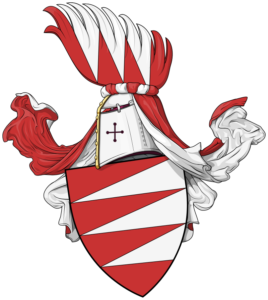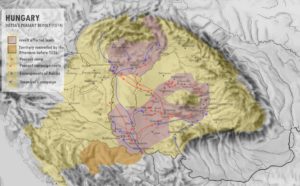Palatine Báthory István (c 1480-1530)

The powerful Báthory family’s ancestor was the German Gutkeled Clan which was invited to Hungary in the 11th century. However, by the 16th century, they considered themselves Hungarian, and I will use the Oriental name order for their names whereas family names came first, according to the Hungarian customs. Now, let us talk about Báthory István who played a significant role in helping Habsburg Ferdinand to seize the Hungarian throne after the Battle of Mohács in 1526.

Báthory István, who came from the Ecsed branch of the family, has been lame since his birth, hence he was nicknamed the “Lame”. His father was Báthory András, a royal stablemaster, and his mother was Rátóti Julianna. His date of birth is unknown, it is thought it was sometime in the mid-1480s. His name appears in the sources since 1490. His wife, whom he married in 1521, was Princess Sophia, daughter of the Prince of Mazovia. He had a son from her. You can read more about Nyírbátor where the headquarter of the family used to be:
https://www.hungarianottomanwars.com/transylvania/nyirbator/

The king appointed him the chief Comes of Szatmár and Zala counties in 1506. He, together with Bornemissza János became the tutor of the young Prince Louis (Lajos), the later King Louis II of Hungary. Between 1508 and 1511 he became the Castellan of Buda castle, it was his rank when he accompanied Prince Louis to be crowned King of the Czechs in 1509. When Louis was crowned, he acted as his teacher.
In 1511, he was appointed as Comes of Temes County and Chief Captain of the Lower Parts of Hungary (he wore this title until 1523). This was a dangerous zone close to the Ottomans, roughly including the counties between the River Maros (Mureş) and the Lower Danube, as well as the counties of Bodrog and Bács. He was very much needed there: on October 12, 1512, he destroyed the raiding Turkish army in the Battle of Illadia, in Krassó County. The church of Nyírbátor was completed at this time, the furnishings of which, according to its inscriptions, were made by him and his two brothers, the chief Stable Mster of the King György and András, the Chief Comes of Szatmár and Szabolcs counties.

However, during the peasant war led by Dózsa György in 1514, he had a rather unfortunate role. The peasants had been initially rallied to launch a Crusade but the money issued for feeding them by the Pope has never arrived or disappeared somewhere. Cardinal Bakócz was unable to stop the campaign, and many noblemen tried to hinder or block their peasants from joining the Crusade against the Ottomans. Báthory was among them. Finally, the hungry peasants rebelled and turned against their lords, and devastated half of the country.

Báthory took up arms against the peasants. In May, in the battle of Apátfalva, Csáky Miklós, together with Bishop Csanád, shattered the vanguard of the peasants. The noblemen thought they had scattered the entire peasant army and got heavily drunk, they were celebrating the victory with their soldiers. Taking advantage of their lack of discipline, Dózsa surprised them at Nagylak. Báthory could hardly escape.
However, being a man more experienced in the art of war, he noticed in time that the enemy was coming from the direction where the others were trying to run. So he set off in the direction from which the peasants were originally expected, eastwards. He managed to reach Solymos Castle safely. Then, Dózsa’s peasants forced him to retreat to Temesvár (Timisoara), and then the peasant armies besieged his castle. Báthory had to turn to the Transylvanian voivode, Szapolyai János, for help.

The two of them were thought to have been lethal enemies of each other, but according to the research of Tóth C. Norbert, they had a very good working relationship with each other. Szapolyai hurried to his help, and in the summer of 1514, The siege of Temesvár was too long, it lasted for a month and the peasant soldiers were losing faith. Szapolyai attacked them and defeated the peasant army at Temesvár and rescued Báthory from his distressing situation. Having mercilessly put down the peasants, the following year they led a war together to siege Zsarnó Castle but the campaign ended unsuccessfully.
The king appointed him royal counselor in 1518, and the following year he was appointed a Palatine. It was the highest rank below the monarch. During the Ottoman siege of Nándorfehérvár aka Belgrad (1521), he marched to the southern border, but due to the outbreak of an epidemic in the army, he could not achieve any results. Nándorfehérvár fell to the Turks, and the southern gate of the kingdom stood ajar before the enemy. The nobility blamed Báthorit for the defeats suffered at the hands of the Turks, although not all the accusations were true. He was blamed for other excesses like fraud, too.

In 1522, when King Louis II and his wife, Habsburg Maria left for Bohemia to settle the kingdom’s issues, he appointed Báthory to be his deputy (locum tenens), who, by this appointment, replaced the king in the judiciary, became the chief governor of the country together with Szapolyai János, the Transylvanian voivode, and was granted the right to make donations of up to 32 manors.

During the Diet held in 1523, the oligarch was replaced because the common nobles suspected him of embezzling seven hundred thousand Forints, of which he kept only half a thousand soldiers in mercenary pay, and of minting counterfeit money with his brother András in Szatmár.

However, was re-appointed as a Palatine the next year. At the Diet of Hatvan in June-July 1525, he was deposed amidst an incredible amount of bickering. His influence in court remained. As his successor, Werbőczy István could not solve the kingdom’s problems, King Lajos (Louis) II re-appointed him after a year. As I have heard, allegedly it was because of the influence of the king’s wife, Queen Habsburg Maria.

Báthory István took part in the battle of Mohács in 1526 as a Palatine, one of the chief commanders. However, it was partly because of this that the Hungarian army fought the battle so clumsily that it ended in disaster. The gouty Báthory fled the battlefield on a rested horse of his servant, Kecskés Pál, and headed for Pécs. (Later, the grateful lord ransomed his servant, Kecskés Pál from his captivity.) He took the members of the chapter of Pécs with their treasures in his retinue and took them with him to Pozsony. Then, he rode straight to his castle at Dévény which was next to Pozsony in a strategic place.

Anyone controlled Dévény, controlled the road between Vienna and Buda. Báthory was one of the few high-ranking noblemen who joined the side of Queen Habsburg Maria, the sister of Habsburg Ferdinand. Perhaps he guessed that his opponent, Szapolyai would have himself crowned very soon. Anyway, Habsburg Ferdinand’s army could not have attacked Hungary if Báthory had blocked his road at Dévény.

The Dual Kingship commenced in Hungary, Ferdinand and Szapolyai were both kings of the country. However, Ferdinand rewarded Báthory by confirming his rank as a Palatine. He also received Dévény and Kőszeg from him in 1528. He repeatedly lent money to the cash-strapped Viennese court and received pledges in return, thus increasing his holdings and power. Until Báthory’s death, Szapolyai hoped to be able to lure his former contestant to his side, though. Szapolyai did not even appoint a palatine until 1530. While Báthory acted as a Palatine, Ferdinand experienced how much power a Palatine really had. Learning from his lesson, he refused to appoint Báthory’s successor until 1554.

Palatine Báthory died in the castle of Dévény, and he was buried by his wife in St. Martin’s Church in Pozsony (Bratislava). There came many more members from the two branches of the Báthory family who filled high offices and changed Hungarian (and Polish) history for the better or for the worse. As for me, Báthory István does not belong to the group of those Báthory family members who were the “good guys”, things would have turned out very differently without him.

Source: Szibler Gábor
Dear Readers, I can only make this content available through small donations or by selling my books or T-shirts.
If you like my writings, please feel free to support me with a coffee here:
You can check out my books on Amazon or Draft2Digital, they are available in hardcover, paperback, or ebook:
https://www.amazon.com/dp/198020490X
or at https://books2read.com/b/boYd81


My work can also be followed and supported on Patreon: Become a Patron!http://Become a Patron!


https://hungarianottomanwars.myspreadshop.com/all



